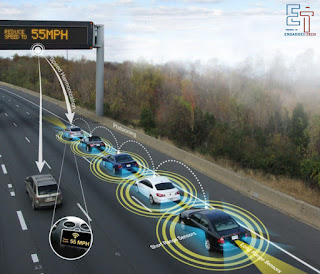Autonomous Vehicles
Introduction
to Autonomous Vehicles:
Self-driving Cars
or Autonomous Cars are vehicles that can operate and steer themselves without
human help. These cars have sensors, cameras, and advanced software that helps
monitor and navigate roads by spotting the presence of an object on the road as
well as following traffic signals and regulations. The idea of the car is to
prevent people's mistakes, which make most the accidents happen. The cars are
meant to create transportation that is not only more efficient but safer and
without human error.

How Autonomous
Vehicles work?
There are just
a few basic technologies behind autonomous vehicles:
1) Sensors and
Cameras
That's what
allows the car to "see" the road and other cars and objects, for
example.
2) Lidar and
Radar
Measures
distances and often can-do things that a camera couldn't, especially in very
bad weather.
3) Artificial
Intelligence (AI)
These systems
measure distances and detect objects that may not be visible to the camera,
especially in poor weather.
4) GPS
The car uses
the GPS to know its exact position and chart the best way to its destination.

Advantages of
Autonomous Cars:
Some advantages
are as follows:
1) Safety
The cars will
reduce accidents since the accident is a result of human error. The self-driven
car is expected to eliminate human driver errors that may arise while speeding
or distracted.
2) Efficiency
Cars can also
talk or otherwise communicate and help the efficiency of traffic, making
minimal traffic congestion thus wasting more time.
3) Saving Costs
The money of
accidents, fuel and up keep will be reduced for self-driving cars.
4) Green
Environment
The
self-driving car will be optimizing its acceleration, braking, and overall
behavior to use as little energy as possible from the vehicle. Many of the
self-driving cars that are expected will likely be electric, saving on carbon
emissions and greener transportation.
5) Speedy
Emergency Response
They will be
likely to respond sooner if some accident occurs, and these self-driving cars
can even be programmed to drive their owners to the nearest hospital if the
case is regarding health. This could, in fact be the rescue in critical
moments.
6) Insurance
Premium Discounts
Accidents will
decline, and driving is secure, so that the premium for insurance in such
automobiles may come low. The more reliable autonomous technology gets, the
lower premiums from the insurance companies may come to the owner of
automobiles.
7) Less Traffic
Autonomous
automobiles will converse with one another to prevent getting stuck and hence
the flow of traffic would sustain itself.
Problems and
Risks in Autonomous Vehicle Development:
Despite this
promising technology, it's still plagued by these problems:
Safety:
Above all, the
technology should perform flawlessly in every scenario so that no mishap takes
place.
Regulations:
Governments
will be bound to formulate new laws and regulations for autonomous cars that
will take time to execute.
Public Trust:
Several publics
fear giving the right to trust a car which drives on its own and primarily
regarding their safety and well-being.
Legally and
Ethically Speaking towards an Autonomous Vehicle:
There are huge
legal and ethical questions one has to consider regarding driverless cars:
Who do you
blame in case it crashes? If a car with no driver behind the steering wheel
crashes, do we blame the owner, its manufacturer, or the developing company of
the software involved?
Privacy Issues:
Self-driving
cars collect such immense data about the places visited and how one gets to
them. Whose data is that?
Job Loss:
Many people
work for a living today, truckers, taxi cab operators, and the like, who would
lose their jobs.
Conclusion:
Self-driving
cars will transform transportation in society with safer, efficient, and
possibly cheaper options for traveling in the world. Though the technology has
advanced much, there are still safety issues to be worked on, public trust, and
legal issues. Because technology is still a field of improvement, these
self-driving cars might soon appear on our roads, making travel easier and
reducing the human errors that lead to accidents. Though exciting, this future
of transport will require careful and discerning planning, regulation, and
consideration of ethical and social implications to make a seemingly smooth
transition into this world of autonomous driving.









0 Comments